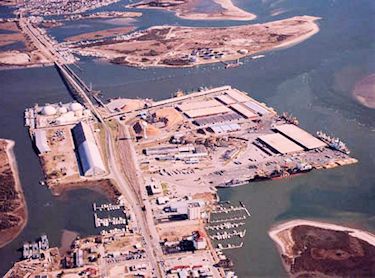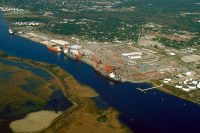MOREHEAD CITY — If offshore drilling took place off the East Coast, it’s unlikely that the N.C. coast would transform into the industrialized nightmare of beaches lined with oil refineries many locals fear. That’s because neither of the state’s port cities make appealing choices for the industry to bring oil or natural gas ashore.
That’s according to David McGowan, the executive director of the N.C. Petroleum Council. The council is a subsidiary of the American Petroleum Institute, the largest trade group for the oil and natural gas industry in the country. “I think the reality is, here in North Carolina, we’re much more likely to see the types of shore-basing and supply operations that would support the offshore industry but not the major infrastructure complexes, like refineries or processing facilities, that a lot of folks anticipate that we might,” McGowan said.
Supporter Spotlight

North Carolina doesn’t have refineries to process oil or natural gas or pipelines to transport them. Given there hasn’t been a new refinery built in the United States since 1976, McGowan says there’s a slim chance industry would build one a new one here.
Early this year the state Department of Commerce presented a report to the N.C. General Assembly on the feasibility of building a liquid natural gas export plant at either the Wilmington or Morehead City ports. The report notes that major hurdles would first have to cleared, including a lengthy permitting and review process, building a network of pipelines, an exporting facility and subsurface natural gas storage and keeping channels to the ports dredged to a depth of about 50 feet to accommodate the ships loading the gas. A more technical analysis is needed to determine profitability.
Here’s another good reason why there’s a slim chance that will happen: “We have fairly robust refining infrastructure right now on the East Coast in the Delaware and Philadelphia area,” said McGowan. “And so, most likely any resource that was produced off the East Coast would make its way to that existing refining infrastructure.”
What Morehead City or Wilmington could offer the industry is a port to supply and service offshore drilling operations with, for example, storage space, supply boats, helicopter bases or equipment manufacturing facilities, McGowan said.
Of the two state ports, Morehead City’s would finally be the golden child, and not the redheaded stepdaughter some in Carteret County have labeled it. Unlike its sister Wilmington port that 26 miles from open sea on the Cape Fear River, the Morehead City port is only four miles from the sea buoy – and less than a mile from Beaufort Inlet.
Supporter Spotlight
Morehead City is also closer to where the resources are expected to be found, based on offshore geology and previous industry interest. The last time the oil industry considered drilling off North Carolina was in the early 1980s, when several companies bought leases off Hatteras Island on the Outer Banks.

“From an efficiency standpoint,” McGowan said, “Morehead is certainly in a good situation. And I think, based on the little bit we know of the resource from the previous studies and information that’s been gathered offshore, the Morehead port is probably better geographically situated than Wilmington in that regard.”
Although Morehead City’s port is the closest port to open sea on the East Coast, it does present some challenges to any major industry wanting to settle in. As David Whitlow, the city manager of Morehead City, explained, there are a few big reasons why the city and its port might not be the obvious or immediate choice for the industry. “We don’t have an interstate highway, so we’re a tough place to get to by truck in volume,” Whitlow said.
Also, the only railroad line runs right through downtown. “Our rail is not an extensive rail system and doesn’t offer a lot of opportunities unless somebody wants to put a lot of money into coming up with a second route,” he said.
“Even the port here,” continued Whitlow, “the main part of the port is pretty well fully developed and committed, so that only leaves Radio Island as a possibility. And Radio Island isn’t the most accessible spot they can have for a port because they have a couple different bridges they have to cross to get there and it doesn’t have a lot of services out there. Access to the existing Route 70, Arendell Street, is challenging at best, even as Radio Island is currently developed. “So without a lot of additional infrastructure going into place there I can’t even see from a highway standpoint how Radio Island would serve to play a significant role. So what does that leave us with?”

Gov. Pat McCrory’s proposed bond referendum, Connect N.C., might be the answer to that question. The bond’s budget includes spending $125 million upgrading Morehead City’s port infrastructure to accommodate larger vessels, $75 million at Wilmington’s port for improvements and repairs and $50 million on expanding the rail system. Part of the governor’s 25-year vision for the region includes upgrading U.S. 70 to interstate standards and building a new rail and highway access bypassing Morehead City and reaching the port from the eastern side.
The channel to the port has also faced years of ongoing challenges with shoaling. “Getting the dredging situation under control is critical,” said McGowan, no matter the activity taking place, he added.
Whitlow said he was present earlier this year at a meeting of the Morehead City Port Committee, a nonprofit group interested in developing port business, when members of the American Petroleum Institute discussed the potential economic benefits of offshore drilling.
N.C. Ports Authority spokesman Cliff Pyron, said port officials are prepared to react if drilling plans move forward. “We could be the receiving facility for these types of projects but have not been approached by any particular business ventures at this point in time,”Pyron said Monday in an email.
Whether Morehead City is prepared to handle the population growth from the industry is another question.
“We’re pretty well fixed for water and sewer, so we have that infrastructure in place,” said Whitlow, “but let’s say 2,000 or 3,000 people came in to support the oil industry. Obviously under our current conditions we don’t have that kind of housing available.”

Both private and public sectors would have to pour their resources into building up for the big influx of workers and their families, he said. More emergency medical personnel, firefighters, police officers, sanitation workers, teachers and doctors would be required. Also, further expansion of the county hospital may be needed, Whitlow noted.
The growing pains expected if industry and jobs were to come and the stress on city resources weren’t Whitlow’s greatest fears. It’s, by nature of the industry, that all those people could be sent packing again a few years later. It’s the typical oil industry “boom and bust” seen in some Oklahoma and Texas towns that’s a bigger concern, he said.
“When (the industry) is growing it has a positive economic impact, although it doesn’t necessarily have a positive community impact; and when it’s dying, it certainly has a negative economic and community impact,” said Whitlow. “Growing too fast is not a good approach to things.”
If the industry selects a site in Morehead City, then city officials would have some say in what the industry could or couldn’t do, said Whitlow. However, if a firm becomes a tenant at the port, “the state does not have to go through a lot of our processes, and we don’t have any particular domain over some of what the state does,” he said.
Ultimately, site selection depends on a number of variables, many of which remain unknown, McGowan said. “All of that is dependent in large part upon what the resource is – is it oil? Is it natural gas, dry gas, is it wet gas? Where is it located exactly? What are some of the potential challenges to not only exploring and producing that product but then getting it to shore to refine and to make into the end product?”







